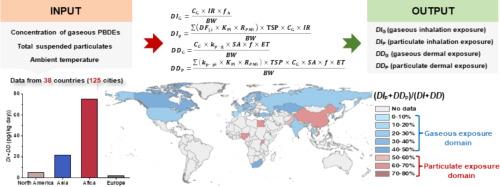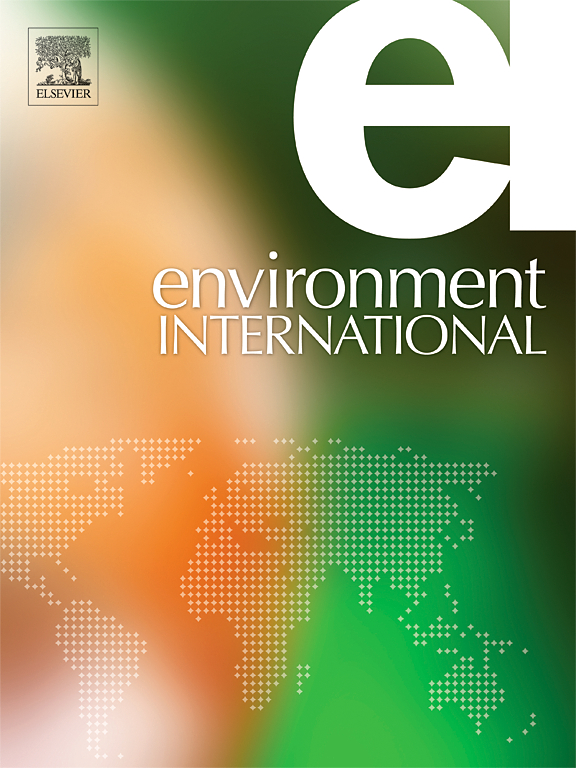全球人类对大气多溴联苯醚的暴露:暴露途径和相位贡献的变化模式
IF 10.3
1区 环境科学与生态学
Q1 ENVIRONMENTAL SCIENCES
引用次数: 0
摘要
目前,对大气中半挥发性有机化合物(SVOCs)对人体暴露的途径和相位贡献的研究还存在一定的局限性。本研究明确了全球范围内颗粒物和气态多溴联苯醚(PBDEs)的吸入和皮肤暴露贡献率及其影响因素和机制。从38个国家和地区的125个城市收集了气态多溴二苯醚的数据,利用我们之前的吸入方法和本研究中开发的皮肤暴露依赖于大小的预测方法,预测大小分辨的颗粒暴露水平。多溴二苯醚的全球气相分布与人均GDP水平呈显著负相关(r = - 0.40, p <; 0.05),导致人类对大气多溴二苯醚的暴露模式相似。非洲的日摄取量最高(75.4 pg/(kg·day)),其次是亚洲(21.8 pg/(kg·day))、北美(5.38 pg/(kg·day))和欧洲(1.92 pg/(kg·day))。吸入途径是人类暴露于大气多溴二苯醚的主要途径。粒子的贡献相总人类接触了欧洲的模式(26.8 %) & lt; 北美(33.5 %) & lt; 亚洲(43.7 %) & lt; 非洲(59.8 %),表现出显著的正相关关系与TSP (r = 0.79,p & lt; 0.01)。一项重要发现是,TSP在70 μg/m3左右波动可能导致人类初次接触阶段的改变。温度对不同个体的低溴多溴二苯醚的颗粒物贡献有不同的负面影响。本研究还开发了一个网络平台,提供SVOCs吸入和皮肤暴露的预测,明显提高了人类对大气多溴二苯醚的暴露评估和暴露模式研究的效率。本文章由计算机程序翻译,如有差异,请以英文原文为准。


Global human exposure of atmospheric polybrominated diphenyl ethers: Variation patterns of exposure pathways and phase contributions
At present, there are still certain limitations in the research on the pathways and phase contributions of semi-volatile organic compounds (SVOCs) to human exposure in the atmosphere. This study clarified the contribution rates of inhalation and dermal exposure of particulate and gaseous polybrominated diphenyl ethers (PBDEs) on a global scale, as well as their influencing factors and mechanisms. Data on gaseous PBDEs were collected from 125 cities across 38 countries and regions to predict size-resolved particulate exposure levels, utilizing our previous method for inhalation alongside a size-dependent prediction method for dermal exposure developed in this study. The global distribution of PBDEs in gas phase showed a significant negative correlation (r = − 0.40, p < 0.05) with the level of per capita GDP, resulting in a similar pattern of human exposure to atmospheric PBDEs. The highest daily intake was found in Africa (75.4 pg/(kg·day)), followed by Asia (21.8 pg/(kg·day)), North America (5.38 pg/(kg·day)) and Europe (1.92 pg/(kg·day)). Inhalation pathways dominated human exposure to atmospheric PBDEs. The contributions of particle phase to the total human exposure presented a pattern of Europe (26.8 %) < North America (33.5 %) < Asia (43.7 %) < Africa (59.8 %), exhibiting a significant positive correlation with TSP (r = 0.79, p < 0.01). An important finding was that the fluctuation of TSP around 70 μg/m3 may lead to alterations in the primary exposure phase for humans. Temperature exerted negative effects on the particulate contribution of low-brominated PBDEs varying in different individuals. In this study, a web platform was also developed, which offered predictions of inhalation and dermal exposures to SVOCs, obviously improving the efficiency of evaluating human exposure to atmospheric PBDEs and researching their exposure patterns.
求助全文
通过发布文献求助,成功后即可免费获取论文全文。
去求助
来源期刊

Environment International
环境科学-环境科学
CiteScore
21.90
自引率
3.40%
发文量
734
审稿时长
2.8 months
期刊介绍:
Environmental Health publishes manuscripts focusing on critical aspects of environmental and occupational medicine, including studies in toxicology and epidemiology, to illuminate the human health implications of exposure to environmental hazards. The journal adopts an open-access model and practices open peer review.
It caters to scientists and practitioners across all environmental science domains, directly or indirectly impacting human health and well-being. With a commitment to enhancing the prevention of environmentally-related health risks, Environmental Health serves as a public health journal for the community and scientists engaged in matters of public health significance concerning the environment.
 求助内容:
求助内容: 应助结果提醒方式:
应助结果提醒方式:


